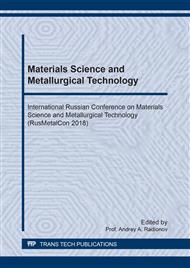[1]
I.G. Zhbankov, A.V. Perig, Intensive Shear Deformation in Billets During Forging with Specially Formed Anvils, Materials and Manufacturing Processes. 28 (2013) 577–583.
DOI: 10.1080/10426914.2013.763974
Google Scholar
[2]
A. Tolkushkin, E. Panin, V. Talmazan. Development and computer modeling of a new forging technology of forgings such as slabs and plates, Journal of Chemical Technology and Metallurgy. 4, Vol. 51 (2016) 443–450.
Google Scholar
[3]
H. Dyja, G. Banaszek, S. Berski, S. Mroz. Effect of symmetrical and asymmetrical forging processes on the quality of forged products, Journal of Materials Processing Technology. 157–158 (2004) 496 – 501.
DOI: 10.1016/j.jmatprotec.2004.07.109
Google Scholar
[4]
S.A. Belujev, V.A. Tiurin, Vlijenije formy slitka i technologii jego kovki na kacestvo pokovok valkov, Kuzn. Stamp. Proizvod. 1 (1985) 7–10 (In Russian).
Google Scholar
[5]
H. Dyja, G. Banaszek, S. Mroz., S. Berski. Modelling of shape anvils in free hot forging of long products, Journal of Materials Processing Technology 157–158 (2004) 131–137.
DOI: 10.1016/j.jmatprotec.2004.09.022
Google Scholar
[6]
V.A. Tiurin. Innovative technologies of forging with macro-shears usage. Kuzn. Stamp. Proizvod. 12 (2007) 8–9 (In Russian).
Google Scholar
[7]
G. Banaszek, A. Stefanik. Theoretical and laboratory modelling of the closure of metallurgical defects during forming of a forging. Journal of Materials Processing Technology 177 (2006) 238–242.
DOI: 10.1016/j.jmatprotec.2006.04.023
Google Scholar
[8]
C.Y. Park, D.Y. Yang. A study of void crushing in large forgings II. Estimation of bonding efficiency by finite-element analysis, Journal of Materials Processing Technology 72 (1997) 32–41.
DOI: 10.1016/s0924-0136(97)00126-x
Google Scholar
[9]
S.K. Choi, M.S. Chun, C.J. Van Tyne, Y.H. Moon, Optimization of open die forging of round shapes using FEM analysis, Journal of Materials Processing Technology 172 (2006) 88–95.
DOI: 10.1016/j.jmatprotec.2005.09.010
Google Scholar
[10]
H. Jafarzadeh, M. Zadshakoyan, Numerical and experimental studies of splines produced by injection forging process, Materials and Manufacturing Processes, 5 (2011) 703–712.
DOI: 10.1080/10426914.2010.496124
Google Scholar
[11]
A.B. Nayzabekov, A.V. Kotelkin, V.A. Petrov, B.K. Vorontsov, Forging of billets with square cross section and billets for forged cubes, Kuzn. Stamp. Proizvod. 10 (1990) 4–6.
Google Scholar
[12]
V.A. Tiurin, Additional macroshears is technological reserves of forging. Kuzn. Stamp. Proizvod. 12 (1993) 8–9 (in Russian).
Google Scholar
[13]
V.A. Tiurin, Innovative technologies in forging. Kuzn. Stamp. Proizvod. 5 (2006) 27–29 (in Russian).
Google Scholar
[14]
A.V. Kotelkin, V.A. Petrov, Combined anvils. USSR Patent 774756, 1980 (in Russian).
Google Scholar
[15]
L.V. Prozorov, G.A. Pimenov, A.A. Kostava, Tool for forging metals and alloys. USSR Patent 442878, 1974 (in Russian).
Google Scholar
[16]
Ya.M. Ohrimenko, V.A. Tyurin, Yu.I. Mishchenkov, Tool for forging. USSR Patent 393018, 1973 (in Russian).
Google Scholar
[17]
V.K. Voroncov, A.B. Najzabekov, A.V. Kotelkin, V.A. Petrov, Conditions of shear deformation development under forging billets by stepped anvils, Izv. Vuz. Chern. Met. 5 (1987) 50–53 (in Russian).
Google Scholar
[18]
G. Banaszek, P. Szota, A comprehensive numerical analysis of the effect of relative feed during the operation of stretch forging of large ingots in profiled anvils, Journal of Materials Processing Technology. 169 (2005) 437–444.
DOI: 10.1016/j.jmatprotec.2005.03.018
Google Scholar
[19]
A. Khajezade, M.H. Parsa, H. Mirzadeh, Crystal Plasticity Analysis of Texture Evolution of Pure Aluminum During Processing by a New Severe Plastic Deformation Technique, Metallurgical and Materials Transactions A: Physical Metallurgy and Materials Science, Vol. 47 Issue 2 (2016) 941–948.
DOI: 10.1007/s11661-015-3227-3
Google Scholar
[20]
A.B. Naizabekov, S.N. Lezhnev, E.A. Panin, Research of the deformation process of blanks in the dies with elastic elements, Journal of Chemical Technology and Metallurgy, Vol. 52, Issue 2 (2017) 205–212.
Google Scholar
[21]
A.A. Bogatov, Mechanical Properties and Fracture Models of Metals, UGTU-UPI, Ekaterinburg, 2002 (in Russian).
Google Scholar
[22]
A.A. Bogatov, D.S. Nukhov, Forging of strip by alternating deformation, with unchanged size and shape, Steel in Translation, Vol. 45, Issue 6 (2015) 412–417.
DOI: 10.3103/s0967091215060054
Google Scholar


